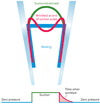Stretch-activated ion channels: what are they?
- PMID: 20134028
- PMCID: PMC2924431
- DOI: 10.1152/physiol.00042.2009
Stretch-activated ion channels: what are they?
Abstract
Mechanosensitive ion channels (MSCs) exist in all cells, but mechanosensitivity is a phenotype not a genotype. Specialized mechanoreceptors such as the hair cells of the cochlea require elaborate mechanical impedance matching to couple the channels to the external stress. In contrast, MSCs in nonspecialized cells appear activated by stress in the bilayer local to the channel--within about three lipids. Local mechanical stress can be produced by far-field tension, amphipaths, phase separations, the cytoskeleton, the extracellular matrix, and the adhesion energy between the membrane and a patch pipette. Understanding MSC function requires under standing the stimulus.
Figures



Similar articles
-
Removal of the mechanoprotective influence of the cytoskeleton reveals PIEZO1 is gated by bilayer tension.Nat Commun. 2016 Jan 20;7:10366. doi: 10.1038/ncomms10366. Nat Commun. 2016. PMID: 26785635 Free PMC article.
-
Thermodynamics of mechanosensitivity.Phys Biol. 2004 Jun;1(1-2):110-24. doi: 10.1088/1478-3967/1/2/007. Phys Biol. 2004. PMID: 16204828
-
Differential effects of lipids and lyso-lipids on the mechanosensitivity of the mechanosensitive channels MscL and MscS.Proc Natl Acad Sci U S A. 2012 May 29;109(22):8770-5. doi: 10.1073/pnas.1200051109. Epub 2012 May 14. Proc Natl Acad Sci U S A. 2012. PMID: 22586095 Free PMC article.
-
Regulation of PIEZO1 channels by lipids and the structural components of extracellular matrix/cell cytoskeleton.J Cell Physiol. 2023 May;238(5):918-930. doi: 10.1002/jcp.31001. Epub 2023 Mar 22. J Cell Physiol. 2023. PMID: 36947588 Review.
-
Biophysical Principles of Ion-Channel-Mediated Mechanosensory Transduction.Cell Rep. 2019 Oct 1;29(1):1-12. doi: 10.1016/j.celrep.2019.08.075. Cell Rep. 2019. PMID: 31577940 Review.
Cited by
-
Molecular mechanism of TRP channels.Compr Physiol. 2013 Jan;3(1):221-42. doi: 10.1002/cphy.c120001. Compr Physiol. 2013. PMID: 23720286 Free PMC article. Review.
-
Artificial neural network model for predicting changes in ion channel conductance based on cardiac action potential shapes generated via simulation.Sci Rep. 2021 Apr 9;11(1):7831. doi: 10.1038/s41598-021-87578-0. Sci Rep. 2021. PMID: 33837240 Free PMC article.
-
Piezo1: properties of a cation selective mechanical channel.Channels (Austin). 2012 Jul-Aug;6(4):214-9. doi: 10.4161/chan.21050. Epub 2012 Jul 1. Channels (Austin). 2012. PMID: 22790400 Free PMC article. Review.
-
Osmoregulation and the Hypothalamic Supraoptic Nucleus: From Genes to Functions.Front Physiol. 2022 May 24;13:887779. doi: 10.3389/fphys.2022.887779. eCollection 2022. Front Physiol. 2022. PMID: 35685279 Free PMC article. Review.
-
Recording of mechanosensitive currents using piezoelectrically driven mechanostimulator.Nat Protoc. 2011 Jun 16;6(7):979-90. doi: 10.1038/nprot.2011.343. Nat Protoc. 2011. PMID: 21720312
References
-
- Andersen OS, Nielsen C, Maer AM, Lundb’k JA, Goulian M, Koeppe RE. Ion channels as tools to monitor lipid bilayer-membrane protein interactions: gramicidin channels as molecular force transducers. Methods Enzymol. 1999;294:208–224. - PubMed
-
- Beech DJ. TRPC1: store-operated channel and more. Pflügers Arch. 2005;451:53–60. - PubMed
-
- Besch SR, Suchyna T, Sachs F. High-speed pressure clamp. Pflügers Arch. 2002;445:161–166. - PubMed
-
- Bett GCL, Sachs F. Whole-cell mechanosensitive currents in rat ventricular myocytes activated by direct stimulation. J Membr Biol. 2000;173:255–263. - PubMed
Publication types
MeSH terms
Substances
Grants and funding
LinkOut - more resources
Full Text Sources
Molecular Biology Databases

